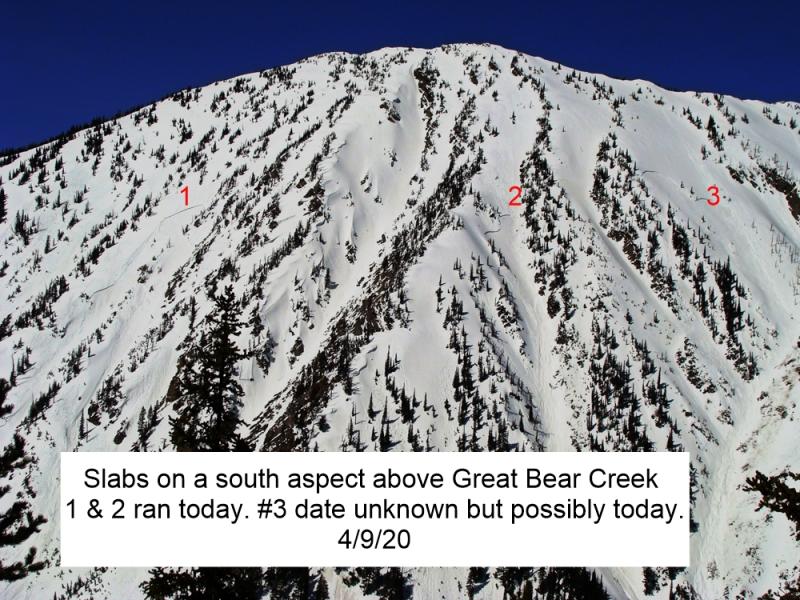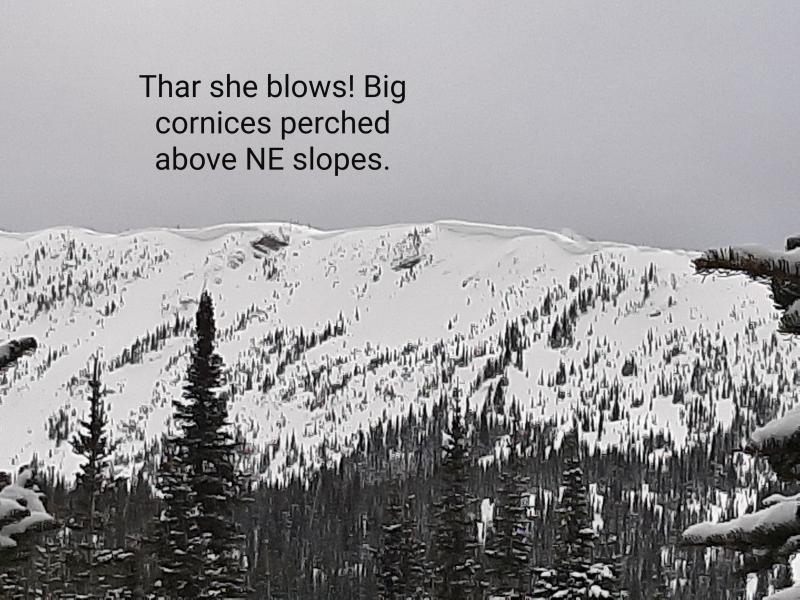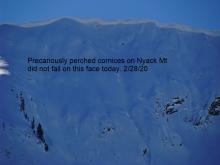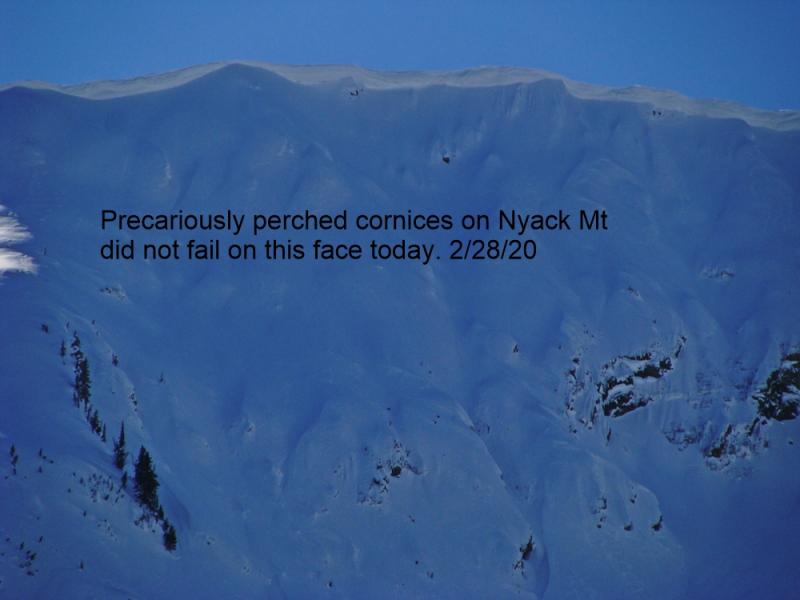| Thursday | Thursday Night | Friday | |
|---|---|---|---|
| Cloud Cover: | Strong winds,cooling temperatures, and showers tapering. | Cool and partly cloudy. | Partly cloudy, decreasing wind, and mild temperatures. |
| Temperatures: | 31-43 deg. F. | 14-22 deg. F. | 37-48 deg. F. |
| Wind Direction: | west-southwest | southwest | south-southeast |
| Wind Speed: | 21-24 gusts 47-53 | 10-12 gusts 24-29 | 4-5 |
| Snowfall: | 0-2 in. | 0 in. | 0 in. |
| Snow Line: |
Whitefish Range
Swan Range
Flathead Range and Glacier National Park
How to read the forecast
Large, natural loose, wet and wet slab avalanches were reported yesterday. Dangerous conditions associated with wet snow will linger until temperatures return to freezing. The avalanche danger is CONSIDERABLE. Sinking deep into the snow on skis or when you step off your machine are signs that the surface snow remains unstable. Also, dig into the snow and look for pooled water above crusts that may indicate wet slab instability. Choose conservative terrain while we wait for the temperature to drop.

3. Considerable
?
Above 6500 ft.
3. Considerable
?
5000-6500 ft.
3. Considerable
?
3500-5000 ft.
- 1. Low
- 2. Moderate
- 3. Considerable
- 4. High
- 5. Extreme
-
Type ?
-
Aspect/Elevation ?
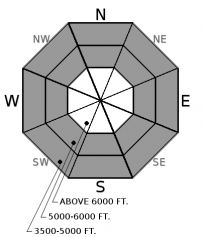
-
Likelihood ?CertainVery LikelyLikelyPossible
 Unlikely
Unlikely -
Size ?HistoricVery LargeLargeSmall

Abundant rain and above freezing temperatures over the past 48 hours created a soggy and weak upper snow pack. A cold front is moving into the area this morning that will help to improve conditions, but until the surface re-freezes it will remain likely to trigger a loose, wet avalanche on any steep slope. Given the amount of snow that fell from late February into early March these wet avalanches have the potential to entrain a lot of snow. Sinking deep into the snow on your skis or when you step off of your machine are a good sign that the surface snow remains unstable. Keep in mind that even short, seemingly benign slopes can be dangerous when the effects of an avalanche are amplified by terrain traps like narrow gullies, cliffs, and trees.
-
Type ?
-
Aspect/Elevation ?

-
Likelihood ?CertainVery LikelyLikelyPossible
 Unlikely
Unlikely -
Size ?HistoricVery LargeLargeSmall

Natural wet slab activity was reported in the John F Stevens Canyon yesterday. A prolonged period of warm, wet weather reaching into the upper elevations pooled melt and rain water above crusts deeper in the snow pack and weakened the bond between the crust and overlying slab. Today as the rain tapers and temperatures fall we should see less natural activity, but instability will linger. Dig into the snow and look for weak, wet interfaces between crusts and slab. Choose conservative terrain until snow pack drains and freezing temperatures return.
-
Type ?
-
Aspect/Elevation ?
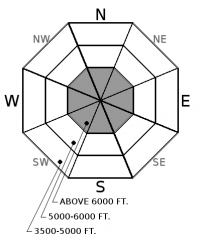
-
Likelihood ?CertainVery LikelyLikelyPossible
 Unlikely
Unlikely -
Size ?HistoricVery LargeLargeSmall

Winds and snowfall from storms earlier this month formed large cornices across our advisory area. Recent warming temperatures and rain weakened these beasts and it is best to give them a wide berth while traveling along ridgelines. BNSF Avalanche Safety observed cornice failures over the past week in John F. Stevens Canyon in southern Glacier Park. Also keep in mind that falling cornices can trigger avalanches on the slopes beneath them so it is important to minimize exposure to slopes where cornices loom above.
In isolated areas a layer of weak sugary snow (facets) sitting on top of the Feb. 10th rain crust produced unstable results in stability tests. I suspect that a few natural avalanches that occured yesterday were associated with that interface. This illustrates the importance of digging into the snow and continuing to assess deeper instabilities particularly after a new, substantial load. In most locations the Feb. 10 crust is buried 2.5 to 4 feet from the snow surface.
Spring can bring a mixed bag of weather conditions to northwest Montana. It can surprise us with intense snow squalls, warm temperatures, and rain-on-snow events (even in the same day). This makes it increasingly important to closely monitor changing conditions. With longer days and a higher sun angle, conditions can rapidly change.
Wednesday: BNSF avalanche safety reported natural avalanche activity in the John F. Stevens Canyon. These loose, wet and wet slab avalanches were estimated at size 2-3 and a few reached the valley floor.
Tuesday: Seth, Todd and Jenny were in the Southern Whitefish Range near Ghoulie Point/Canyon Creek. Snow levels had reached over 6800 feet by the end of the day, rain was plentiful and the upper layers of the snowpack were becoming saturated. Rollerball and pinwheel activity was widespread and there was some cracking in the surface snow. Pits identified some weaknesses in the new snow, but no propagation occurred and no natural activity was observed. By afternoon, the warming and additional liquid precipitation was making it possible to trigger very small, wet loose avalanches on steep terrain.
See below for all observations this season.
This week saw a sharp transition into Spring. Since Monday wet and mild conditions persisted. Temperatures have generally been above freezing to about 6500 feet and we picked up 1-3 inches of rain. 0.5-1.1 inches fell in the past 24 hours. Currently, temperatures above 6000 feet are falling and range from 30-36ºF. Winds are out of the southwest and west-southwest at 7-16 mph with gusts from 13-30 mph. Today should see cooling temperatures, increasing southwest winds, and decreasing showers as a cold front moves into the region. We should remain dry from mid-day today through most of tomorrow.
| 0600 temperature: | 30-36 deg. F. |
| Max. temperature in the last 24 hours: | 34-41 deg. F. |
| Average wind direction during the last 24 hours: | Southwest |
| Average wind speed during the last 24 hours: | 10-20 mph |
| Maximum wind gust in the last 24 hours: | 25-48 mph |
| New snowfall in the last 24 hours: | 0 inches |
| Total snow depth: | 88-121 inches |
This advisory applies only to backcountry areas outside established ski area boundaries. This advisory describes general avalanche conditions and local variations always occur. This advisory expires at midnight on the posted day unless otherwise noted. The information in this advisory is provided by the USDA Forest Service who is solely responsible for its content.













